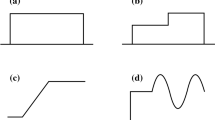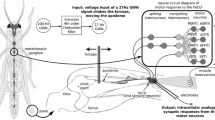Abstract
The response of primary muscle spindle afferent fibers to muscle stretch is nonlinear. Now spindle responses (trains of action potentials) to band-limited Gaussian white noise length perturbations of the gastrocnemius muscles (input signal) are described in cats. The input noise upper cutoff frequency was clearly above the frequency range of physiological length changes in cat hindleg muscles. The input-output relation was analyzed by means of peri-spike averages (PSAs), which could be shown to correspond to the kernels of Wiener's white noise approach to systems identification. The present approach (the reverse correlation analysis) was applied up to the third order. An experiment consisted of two recordings: one (the source recording) to determine PSAs and the other (the test recording) to provide an input signal for predicting responses. The predictions of different orders were compared with the actual neuronal response (the observation) of the test recording. Four different approximation procedures were developed to adapt prediction and observation and to determine weighting factors for the predictions of different orders. The approximations also yielded the value of the power density P of the input noise signal: at a variety of stimulus parameters, P from approximations had the same magnitude as P determined directly from the input signal amplitude spectrum. The prediction of a sequence of action potentials improved the higher the order of components. 37 of 42 action potentials of a test recording (the observation) could be confidently predicted from PSAs or kernels. Compared with the size of the linear first-order prediction curve, the relative sizes of the second and third-order prediction curves were: 1.0∶0.47∶0.26.
Similar content being viewed by others
References
Baker CL, Hartline DK (1978) Nonlinear systems analysis of repetitive firing behaviour in the crayfish stretch receptor. Biol Cybern 29:105–113
Boer de E, Kuyper P (1968) Triggered correlation. IEEE Biomed Eng 15:169–179
Bryant HL, Segundo JP (1976) Spike initiation by transmembrane current: a white-noise analysis. J. Physiol (Lond) 260:279–314
Eggermont JJ, Johannesma PIM, Aertsen AMH (1983) Reverse-correlation methods in auditory research. Q Rev Biophys 16:341–414
French AS, Korenberg MJ (1989) A nonlinear cascade model for action potential encoding in an insect sensory neuron. Biophys J 55:655–661
French AS, Wong RKS (1977) Non-linear analysis of sensory transduction in an inset mechano-receptor. Biol Cybern 26:231–240
Granit R, Henatsch HD (1956) Gamma control of dynamic properties of muscle spindles J Neurophysiol 19:356–366
Grüsser O-J, Thiele B (1968) Reaktionen primärer und sekundärer Muskelspindelafferenzen auf sinusfömige mechanische Reizung. I. Variation der Sinusfrequenz. Pflügers Arch 300:161–184
Houk JC, Rymer WZ, Crago PE (1981) Dependence of dynamic response on spindle receptors on muscle length and velocity. J Neurophysiol 46:143–166
Hulliger M, Matthews PBC, Noth J (1977) Static and dynamic fusimotor action on the response of Ia fibres to low frequency sinusoidal stretching of widely ranging amplitude. J Physiol 267:811–838
Kondoh Y, Morishita H, Arima T, Okuma J, Hasegawa Y (1991) White noise analysis of graded response in a wind-sensitive, nonspiking interneuron of the cockroach. J Comp Physiol 168:429–443
Korenberg MJ (1988) Identifying nonlinear difference equation and functional expansion representations: the fast othogonal algorithm. Ann Biomed Eng 16:123–142
Korenberg MJ, French AS, Voo SKL (1988) White-noise analysis of nonlinear behaviour in an insect sensory neuron: kernel and cascade approaches. Biol Cybern 58:313–320
Korenberg MJ, Sakai HM, Naka K-I (1989) Dissection of the neuron network in the catfish inner retina. II. Interpretation of spike kernels. J Neurophysiol 61:1110–1120
Krausz HI, Friesen WO (1977) The analysis of nonlinear synaptic transmission. J Gen Physiol 70:243–265
Kröller J (1992) Band-limited white noise stimulation and reverse correlation analysis in the prediction of impulse responses of encoder models. Biol Cybern 67:207–215
Kröller J (1993) Reverse correlation analysis of the stretch response of primary muscle spindle afferent fibers. Biol Cybern 69:447–456
Kröller J, Grüsser O-J (1982) Responses of cat dorsal spino-cerebellar tract neurons to sinusoidal stretching of the gastrocnemius muscle. Pflügers Arch 395:99–107
Kröller J, Weiss L (1983) The silent period in the stretch response of Ia-activated dorsal spino-cerebellar tract neurons to sinusoidal muscle stretch in cats. Biol Cybern 48:195–199
Kröller J, Grüsser O-J, Weiss L (1985) The response of primary muscle spindle endings to random muscle stretch: a quantitative analysis. Exp Brain Res 61:1–10
Kröller J, Grüsser O-J, Weiss L-R (1988) Superimposing noise linearizes the response of primary muscle spindle afferents to sinusoidal muscle stretch. Biol Cybern 60:131–137
Lee YW, Schetzen M (1965) Measurement of the Wiener kernels of a nonlinear system by cross-correlation. Int J Control 2:237–254
Lennerstrand G, Thoden V (1968) Dynamic analysis of muscle spindle endings in the cat using length changes of different length-time relations. Acta Physiol Scand 73:234–250
Mancini M, Madden BC, Emerson RC (1990) White noise analysis of temporal properties in simple receptive fields. Biol Cybern 63:209–219
Marmarelis PZ, Marmarelis VZ (1978) Analysis of physiological systems. Plenum Press, New York
Marmarelis PZ, Naka K-I (1973) Nonlinear analysis and synthesis of receptive field responses in the catfish retina. II. One-input white noise analysis. J Neurophysiol 36:619–633
Marmarelis VZ, Citron MC, Vivo CP (1986) Minimum-order Wiener modelling of spike-output systems. Biol Cybern 54:115–123
Matthews PBC (1963) The response of deefferented muscle spindle receptors to stretching at different velocities. J Physiol (Lond) 168:600–678
Moore GP, Auriemma RA (1985) Prediction of muscle stretch receptor behaviour using Wiener kernels. Brain Res 331:185–189
Moore GP, Stuart DG, Stauffer GK, Reinking R (1975) White noise analysis of mammalian muscle receptors. In: McCann GD, Marmarelis (eds) Proceedings of First Symposium on Testing and Identification on Nonlinear Systems. California Institute of Technology, Pasadena, Calif, pp 316–324
Naka KI, Sakai HM (1991) The message in optic nerve fibers and their interpretation. Brain Res Rev 16:135–149
Palm G, Poggio T (1977) Wiener-like system identification in physiology. J Math Biol 4:375–381
Pöpel B, Querfurth H (1984) The transducer and encoder of frog muscle spindles are essentially nonlinear: physiological conclusions from white-noise analysis. Biol Cybern 51:21–32
Poppele RE (1981) An analysis of muscle spindle behaviour using randomly applied stretches. Neuroscience 6:1157–1165
Sakai HM, Naka K-I, Korenberg MJ (1988) White noise analysis in visual neuroscience. Vis Neurosci 1:287–296
Sakuranaga M, Ando Y-I, Naka K-I (1987) Dynamics of the ganglion cell response in the catfish and frog retinas. J Gen Physiol 90:229–259
Schäfer SS (1973) The characteristic curves of the dynamic response of primary muscle spindle endings in the absence and presence of stimulation of fusimotor fibers. Brain Res 59:395–399
Schellart NAM, Spekreijse H (1972) Dynamic characteristics of retinal ganglion cell responses in goldfish. J Gen Physiol 59:1–21
Spekreijse H, Oosting H (1970) Linearizing: a method for analysing and synthesizing nonlinear systems. Kybernetik 7:22–31
Stuart D, Ott K, Ishikawa K, Eldred E (1965) Muscle receptor responses to sinusoidal stretch. Exp Neurol 13:82–95
Wickesberg RE, Geisler CD (1984) Artifacts in Wiener kernels estimated using Gaussian white noise. IEEE Biomed Eng 31:454–461
Wiener N (1988) Nonlinear problems in random theory. Wiley, New York
Wray J, Green CGR (1994) Calculation of the Volterra kernels of non-linear dynamic systems using an artificial neural network. Biol Cybern 71:187–195
Author information
Authors and Affiliations
Rights and permissions
About this article
Cite this article
Kröller, J. Third-order reverse correlation analysis of muscle spindle primary afferent fiber responses to random muscle stretch. Biol. Cybern. 74, 9–20 (1996). https://doi.org/10.1007/BF00199133
Received:
Accepted:
Issue Date:
DOI: https://doi.org/10.1007/BF00199133




